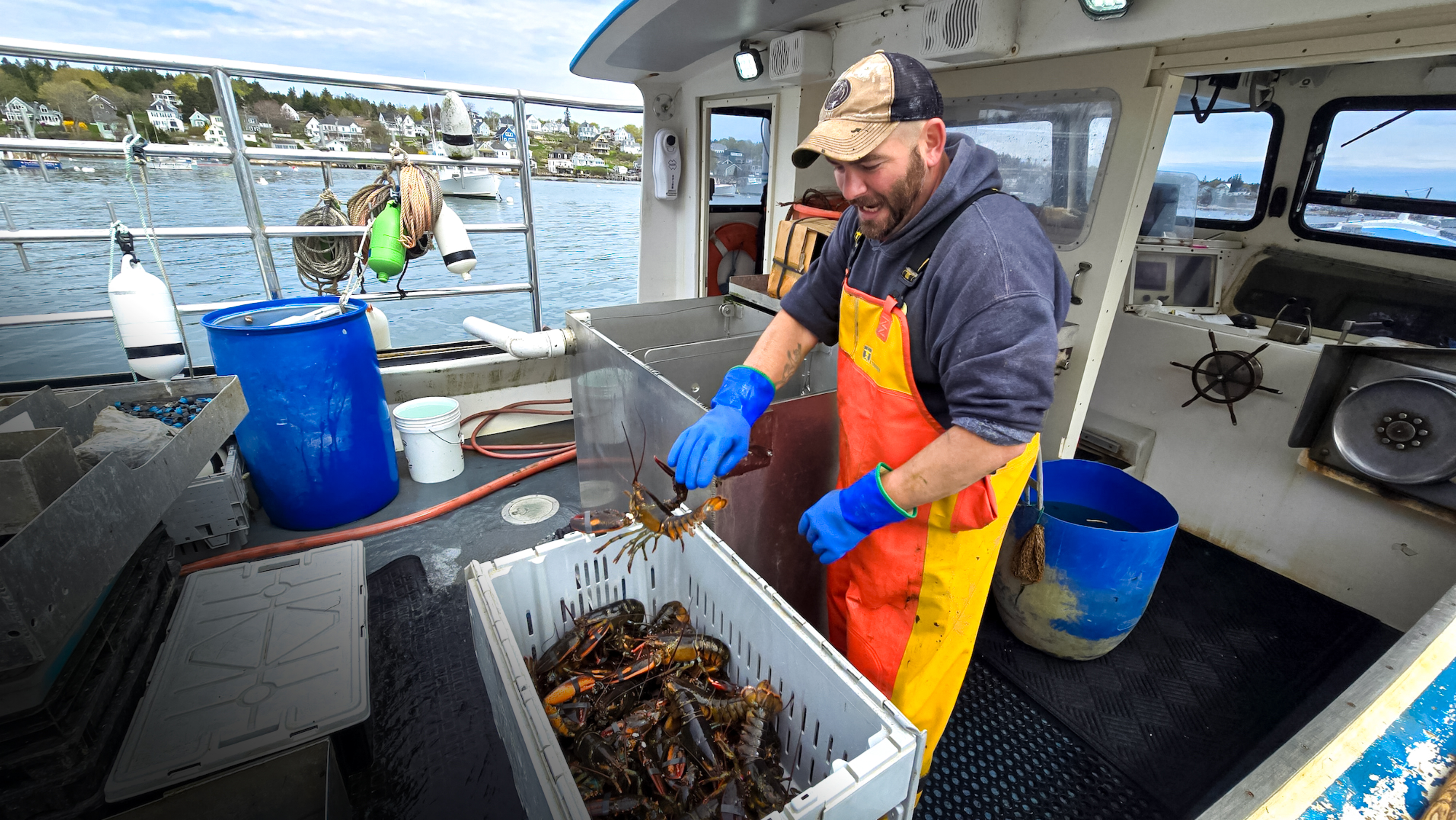STONINGTON, Maine—For veteran lobsterman Travis Dammier, it was the end of another trip at sea on a solo voyage to earn a living.
He was approaching home, feeling less than excited as he navigated his fishing boat, My Kassandra, through the calm waters back to the commercial port of Stonington, Maine.
With little fanfare, the 36-foot vessel powered effortlessly toward the Greenhead Lobster Co. dock, stopping on its starboard side.
Dammier moved quickly as he secured the vessel with thick ropes.
Two dockworkers greeted him, and together they began transferring the live lobsters into large plastic containers for sale in the local market.
Dammier was pleased to return safely with his moving cargo, ready to sell in bulk, even though this landing was light at 140 pounds.
After factoring in expenses for fuel and bait, he estimated his profit at about $100 for three hours of hard labor.
He knew that he needed to check more traps and make additional trips to ensure that his time and effort would be worthwhile.
Dammier fondly recalled the glorious days of lobster fishing closer to shore, when daily catches could exceed 1,000 pounds and yield substantial profits.
Those years of abundance seemed like they’d never end, but they eventually did.
Now, Dammier is compelled by circumstance to venture further out to sea and spend extended periods away from Stonington, about halfway up the Maine coastline.
New Challenges
Making a living from lobster fishing has become increasingly difficult for experienced independent lobstermen such as Dammier.The rising costs of doing business, along with uncertain profits and declining landing volumes since the exceptional peaks of the 1990s and 2000s, all contribute to the challenges faced in this industry.
Dammier’s profound love for lobster fishing—a passion inherited from his grandfather—is the only constant.
At 41, he is tall and easygoing. He wears a baseball cap and a gray hooded sweatshirt with rolled sleeves, layered underneath bright orange-and-yellow waterproof coveralls.
His trimmed beard gives him the appearance of a seasoned sailor; his expression is steady as he gazes out over the tranquil water.
Working alone on a lobster boat presents its unique challenges, Dammier told The Epoch Times.

“I’ve been fishing on my own for eight years now. I’m hauling my regular hauls by myself,” he said.
Dammier still has a scar on his right forearm from an injury he sustained when he fell overboard.
The boat ran over him, slicing into his arm. He managed to pull himself back on board and survived to fish another day.
Even if he had the funds to hire an additional deckhand in these belt-tightening times, Dammier said it is difficult to find qualified workers.
“I think it’s because it is hard work,“ he said. ”These new generations just don’t have the ethic.”
Dammier said many experienced lobstermen are leaving the business because of rising operating costs and state regulations.
He said some of Stonington’s independent operators were “bigger dogs” in their day, but time, as well as physical wear and tear, also took a toll on them.
“I know a lot of guys who sold out over the past couple of years with all these regulations—all the doom and gloom” surrounding the future of the lobster fishing industry, Dammier said.
During the peak years of lobster fishing in Stonington, when daily catches averaged 500 pounds to 600 pounds, or more, Dammier fished closer to shore, which made his job less expensive.
“I used to fish right up in there, inside that island—right there,” he said, pointing.
It has been four years since he placed a lobster trap in those narrow shoals and put down bait north of Fog Island, northeast of Bar Harbor, about 60 miles from Stonington.
Dammier said the lobsters are no longer as abundant in these locations as they once were. He now has to travel farther and for longer, increasing costs, trips, and the risk of injury.

“You have to go into deeper water—go out further or first,” he said.
Along Maine’s rugged 228-mile coastline, filled with forested islands and stony inlets, lobster catches have declined for the third consecutive year, dropping from 111 million pounds in 2021, to about 87 million pounds in 2024.

With a population of 1,056, Stonington became a separate town in 1897, having previously been part of Deer Isle. It has continued to be a crucial hub of the lobster fishing industry and a tourist destination.
What Has Changed?
Over the past century, yearly lobster catches in the state have varied greatly, falling to an all-time low of 5.3 million pounds in 1934.Maine’s annual lobster catch hit a record high in 2016, totaling 132.6 million pounds, with a market value of $540.6 million.
Patrice McCarron, president of the Maine Lobstermen’s Association, said that a common misconception is that lobsters are moving to the colder northern waters of Canada, which contributes to the depletion of Maine’s lobster stock.
“I would say the lobsters aren’t moving anywhere. It’s more that the center of abundance where they’re most available has shifted to deeper waters,” she told The Epoch Times.

As a result, the lobster population in southern New England fell by 78 percent, while the population in the Gulf of Maine increased by 515 percent.
The organization credited the substantial increase to successful conservation efforts.
Adult lobsters thrive in water temperatures of about 50 degrees. However, temperatures above 65 degrees can stress them, negatively affecting their eight-year breeding cycle.
While there has been some warming in the Gulf of Maine, McCarron said that its ecosystem differs from southern New England’s.
“We get a lot of the Arctic melt coming into the Gulf of Maine, as well. Sometimes, that water sinks to the ocean bottom,” she said.
“We’ve had years of warmth, but nothing that’s outside of what a lobster would stop tolerating.”
McCarron said that a decline in lobster landings typically follows each boom, yet fishing companies become accustomed to the profitable yields.
“I think the peak was much more than we had ever really expected the resource would provide us,“ she said. “There was an expectation in the industry that at some point, the landings were going to trail off.”

Soft Landings
Ron Trundy, manager of the Stonington Lobster Co-Op, has also observed lobster catches decline from their peak highs and level out.“Some years, it would be a little less, some more,” he said.
Trundy said that lobster fishing remains profitable, despite rising costs causing frustration among many in the industry.
He said that prices for fishing gear have increased markedly—doubling in some cases—but the fluctuating cost of lobsters does not reflect these increases.
“The investment is way higher now than even 10 years ago,” Trundy told The Epoch Times. “The expenses are very high now. The business is changing.”
Twenty years ago, the cost to build a lobster boat was about $150,000. Now, it costs between $500,000 and $600,000, he said.
Before the COVID-19 pandemic, a wire lobster trap cost about $60. Now, lobster boat operators expect to pay as much as $150.
“If you buy all used traps, it would be [$50] apiece—800 traps is your limit—plus all the rigging. I mean, you’re looking at $250,000 to get started. That’s the bare minimum,” Trundy said.
“These guys make a living at it. But it is harder.”
Lobster fishing has lost its appeal to younger generations, he said.
“It doesn’t have the same attraction. Some guys do other stuff in the winter. They'll do carpentry or whatever.”
Carla Guenther, chief scientist at the Maine Center for Coastal Fisheries in Stonington, said that climatic changes could affect the long-term growth and sustainability of the lobster industry.

“The lobsters aren’t migrating as individuals. They’re not migrating north to colder water,“ she said. ”It’s just that they are not coming as far inshore as they used to.
“It also might be that in recent years it was a dissolved oxygen situation to the west. There was low oxygen, so in those deeper areas, there wasn’t suitable habitat for them.”
Geoff Irvine, executive director of The Lobster Council of Canada, acknowledged that lobsters are not migrating into Canadian waters.
Distance Work
Stonington Deputy Harbor Master Cory Robertson manages 537 moorings in the town harbor, of which 400 are primarily for fishing vessels.Robertson said that a lower return on investment leads to increased hardship for Stonington’s lobster fishermen and the industry as a whole.
He said that the weak labor market and the lack of housing to accommodate any increase in the seafaring workforce only exacerbate the situation.
“A lot of the lobstermen are traveling to get to work,” Robertson told The Epoch Times.
“They’re coming from Bangor, leaving at 2:30 or 3 in the morning. They leave home by midnight at the latest to get down here, then they turn around and drive back, then they turn around and do it again—every day.”
“People are getting out of the industry because they’re just not getting the same catch.
“A lot of them are getting older. They’re ready to retire.”

Nonetheless, he said he hopes that the lobster industry will adapt to the changing market conditions.
“It’s in the blood,” Robertson said of lobster fishing.
Leslie Rice, manager of Cry Babies restaurant in Stonington, said she purchases 100 pounds of lobster from Stonington boat operators every two days.
The price changes constantly.
“You never know what it will be from year to year. With the economy, prices are increasing on everything,” she said.
Rice said she considers lobster fishing as the heartbeat of the Stonington economy. Local restaurants rely on their products, and tourists travel long distances to enjoy Stonington lobster, she said.
Rice said she believes that state regulations are “killing” the industry by imposing restrictions on where lobster boats can fish and on the equipment that they can use to protect aquatic species, such as the North Atlantic right whale.
Moreover, there aren’t many options to earn a living aside from fishing, tourism, and carpentry, Rice told The Epoch Times.
“I see a lot of captains looking for crew. It is just not what it used to be,” she said.
The average hourly wage for a lobster fisherman in the United States is $19, with annual salaries ranging from $29,000 to $52,000, according to a search on ZipRecruiter.
McCarron said that while the state offers apprenticeship programs for young lobster harvesters, the goal is to reduce the number of license holders to promote a more sustainable fishery.

The Price of Success
Kathleen Reardon, lead lobster biologist at the Maine Department of Marine Resources, said that as lobsters proliferate in deeper waters, it becomes increasingly complex for lobster harvesters to reach them.“I think that profitability and inflation are impacting the cost of everything,“ she said. ”Everything costs more, yet they are catching fewer lobsters.”
Reardon said that more than half of Maine’s lobster landings occur within three miles of the shoreline. However, the pressure to travel beyond three miles is rising.
This trend has significant implications for lobster harvesters, as only about 1,300 Maine license holders can access federal waters, she said.
“If the lobsters are not coming as close to shore in high numbers, then people don’t have access,” Reardon told The Epoch Times. “If they have a small boat and can’t go very far, they don’t have access to them. It’s a changing dynamic.”
For Dammier, the time and effort spent on lobster fishing often determine the rewards that he receives.
“I can’t see myself doing anything else,“ he said. ”I’ll try to get 200 days a year—for 200 days, I’ll go out quite a bit.
“This year, I gotta go—gotta keep going.”
With those words, Dammier turned the ignition and started My Kassandra before taking the wheel for another trip out to sea.
Slowly, the vessel drifted away from the dock and glided out of the harbor, heading toward the glimmering bay.
There were more lobsters to catch, and plenty of daylight remained before he could rest.















